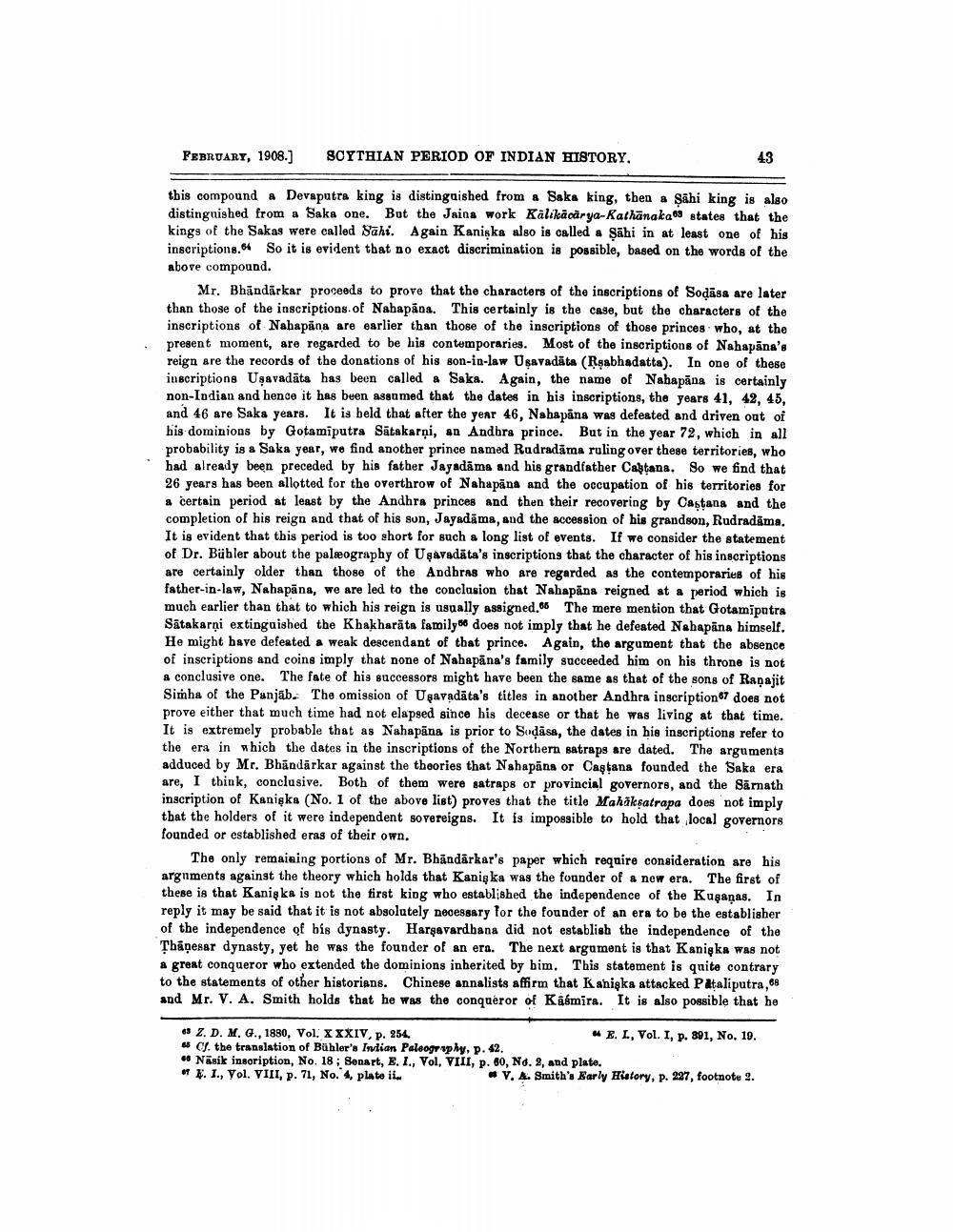________________
FEBRUARY, 1908.)
SCYTHIAN PERIOD OF INDIAN HISTORY,
43
this compound a Devaputra king is distinguished from a Saka king, then a Sähi king is also distingnished from a Saka one. But the Jains work Kalikācar ya-Kathanaka 6 states that the kings of the Sakas were called Sahi. Again Kanişka also is called a şāhi in at least one of his inscriptions. So it is evident that no exact discrimination is possible, based on the words of the above compound.
Mr. Bhāndārkar proceeds to prove that the characters of the inscriptions of Sodāsa are later than those of the inscriptions of Nahapana. This certainly is the case, but the characters of the inscriptions of Nabapāna are earlier than those of the inscriptions of those princes who, at the present moment, are regarded to be his contemporaries. Most of the inscriptions of Nahapana's reign are the records of the donations of his son-in-law Uşavadāts (Rşabhadatta). In one of these inscriptions Uşavadāts has been called a Saka. Again, the name of Nahapāna is certainly non-Indian and hence it has been assumed that the dates in his inscriptions, the years 41, 42, 45, and 46 are Saka years. It is beld that after the year 46, Nahapana was defeated and driven out of his dominions by Gotamiputra Satakarņi, an Andhra prince. But in the year 72, which in all probability is a Saka year, we find another prince named Rudradāma ruling over these territories, who had already been preceded by his father Jayadāma and his grandfather Caštana. So we find that 26 years has been allotted for the overthrow of Nahapana and the occupation of his territories for a certain period at least by the Andhra princes and then their recovering by Castana and the completion of his reign and that of his son, Jayadāms, and the accession of his grandson, Rudradāma. It is evident that this period is too short for such a long list of events. If we consider the statement of Dr. Bühler about the palæography of Uşavadāta's inscriptions that the character of his inscriptions are certainly older than those of the Andbras who are regarded as the contemporaries of his father-in-law, Nahapāna, we are led to the conclusion that Nahapana reigned at a period which is much earlier than that to which his reign is usually assigned. The mere mention that Gotamiputra Satakarņi extinguished the Khakharäta family does not imply that he defeated Nahapana himself. He might have defeated a weak descendant of that prince. Again, the argument that the absence of inscriptions and coins imply that none of Nabapāna's family succeeded him on his throne is not a conclusive one. The fate of his successors might have been the same as that of the sons of Raņajit Simha of the Panjab. The omission of Ugavadāta's titles in another Andhra inscription67 does not prove either that much time had not elapsed since his decease or that he was living at that time. It is extremely probable that as Nahapāna is prior to Sodasa, the dates in his inscriptions refer to the era in which the dates in the inscriptions of the Northern satraps are dated. The arguments adduced by Mr. Bhāndārkar against the theories that Nahapāns or Castana founded the Saka era are, I think, conclusive. Both of them were satraps or provincial governors, and the Sämnath inscription of Kanika (No. 1 of the above list) proves that the title Mahäksatrapa does not imply that the holders of it were independent sovereigns. It is impossible to hold that local governors founded or established eras of their own.
The only remaining portions of Mr. Bhāndārkar's paper which require consideration are his arguments against the theory which holds that Kanişka was the founder of a new era. The first of these is that Kanişka is not the first king who established the independence of the Kuşanas. In reply it may be said that it is not absolutely necessary for the founder of an era to be the establisher of the independence of his dynasty. Harşavardhana did not establish the independence of the Thāņesar dynasty, yet he was the founder of an era. The next argument is that Kanisks was not a great conqueror who extended the dominions inherited by bim. This statement is quite contrary to the statements of other historians. Chinese annalists affirm that Kaniska attacked P taliputra,68 and Mr. V. A. Smith holds that he was the conqueror of Kasmira. It is also possible that he
Z. D. M. G., 1880, Vol. XXXIV. p. 254
E. L, Vol. I, p. 801, No. 19. # CS. the translation of Bühler's Indian Paleogrphy, p. 42. * Näsik inscription, No. 18; Senart, B. I., Vol. VIII, p. 60, NO. 2, and plate. of $. 1., Vol. VIII, p. 71, No. 4, plato ii.
# V. A. Smith's Early History, p. 227, footnote 9.




